Probabilistic Prediction of Floating Offshore Wind Turbine Platform Motions via Uncertainty Quantification and Information Integration
Abstract
1. Introduction
2. Prior Motion Response Analysis
3. Statistical Analysis of Platform Motion Monitoring Data
- Let be the recorded platform motion monitoring signals of one DOF without duplicate data and calculate the mean value motion of this DOF. (n is the number of non-duplicate platform motion monitoring data, ).
- Let the initial , starting from to ; find the that satisfies .
- If , plug the absolute value of into the ( means positive direction) array.
- If , plug the absolute value of into the ( means negative direction) array.
- Calculate the mean value of the cell in the array and calculate the mean value of the array.
- Compare the absolute value of these data. The array that has a larger mean value would be implemented in the Bayesian updating.
4. MCMC-Based Bayesian Updating
4.1. Bayesian Framework
- Use the MCMC method to sample from the posterior distribution , obtaining a set of parameter samples .
- For each parameter sample , calculate .
- Take the average of to approximate .
4.2. Metropolis–Hasting Algorithm
- Assume an initial value .
- Draw a sample from a proposal distribution .
- Accept as the next sample with probability and keep as the next sample with probability , where.is the target distribution, also known as the probability density function that we are trying to sample from.
- Increment and repeat steps 2 and 3 until the desired number of samples is met.
5. Case Study: Hywind Scotland
5.1. Brief Introduction of the Hywind Wind Farm
5.2. The Dimensions of Hywind and Some Considerations
5.3. Source of Platform Motion Monitoring Data
5.4. Prior Analysis by Numerical Simulation
5.4.1. Natural Periods
5.4.2. Motion Response Results
5.5. Platform Motion Monitoring and Bayesian Updating
6. Conclusions
Author Contributions
Funding
Institutional Review Board Statement
Informed Consent Statement
Data Availability Statement
Acknowledgments
Conflicts of Interest
References
- Esteban, M.D.; Diez, J.J.; López, J.S.; Negro, V. Why offshore wind energy? Renew. Energy 2011, 36, 444–450. [Google Scholar] [CrossRef]
- Sun, K.; Xu, Z.; Li, S.; Jin, J.; Wang, P.; Yue, M.; Li, C. Dynamic response analysis of floating wind turbine platform in local fatigue of mooring. Renew. Energy 2023, 204, 733–749. [Google Scholar] [CrossRef]
- Veers, P.; Dykes, K.; Lantz, E.; Barth, S.; Bottasso, C.L.; Carlson, O.; Clifton, A.; Green, J.; Green, P.; Holttinen, H. Grand challenges in the science of wind energy. Science 2019, 366, eaau2027. [Google Scholar] [CrossRef] [PubMed]
- Guedes Soares, C. Quantification of Model Uncertainty in Structural Reliability; Springer: Berlin/Heidelberg, Germany, 1997; pp. 17–37. [Google Scholar]
- Robertson, A.N. Uncertainty analysis of OC5-DeepCwind floating semisubmersible offshore wind test campaign. In Proceedings of the 27th International Ocean and Polar Engineering Conference, San Francisco, CA, USA, 25–30 June 2017. [Google Scholar]
- Simos, A.N.; Ruggeri, F.; Watai, R.A.; Souto-Iglesias, A.; Lopez-Pavon, C. Slow-drift of a floating wind turbine: An assessment of frequency-domain methods based on model tests. Renew. Energy 2018, 116, 133–154. [Google Scholar] [CrossRef]
- Yang, P.; Li, J.; Zhang, W.; Wu, D.; Gu, X.; Ma, Q. Analysis on statistical uncertainties of wave loads and structural fatigue reliability for a semi-submersible platform. Ocean Eng. 2021, 237, 109609. [Google Scholar] [CrossRef]
- Popko, W.; Robertson, A.; Jonkman, J.; Wendt, F.; Thomas, P.; Müller, K.; Kretschmer, M.; Ruud Hagen, T.; Galinos, C.; Le Dreff, J.-B. Validation of numerical models of the offshore wind turbine from the alpha ventus wind farm against full-scale measurements within OC5 phase III. In Proceedings of the International Conference on Offshore Mechanics and Arctic Engineering, Glasgow, UK, 9–14 June 2019. [Google Scholar]
- Robertson, A.N.; Gueydon, S.; Bachynski, E.; Wang, L.; Jonkman, J.; Alarcon, D.; Amet, E.; Beardsell, A.; Bonnet, P.; Boudet, B. OC6 Phase I: Investigating the underprediction of low-frequency hydrodynamic loads and responses of a floating wind turbine. J. Phys. Conf. Ser. 2020, 1618, 032033. [Google Scholar] [CrossRef]
- Wang, L.; Robertson, A.; Jonkman, J.; Yu, Y.-H. OC6 phase I: Improvements to the OpenFAST predictions of nonlinear, low-frequency responses of a floating offshore wind turbine platform. Renew. Energy 2022, 187, 282–301. [Google Scholar] [CrossRef]
- Li, H.; Bachynski-Polić, E.E. Analysis of difference-frequency wave loads and quadratic transfer functions on a restrained semi-submersible floating wind turbine. Ocean Eng. 2021, 232, 109165. [Google Scholar] [CrossRef]
- Wang, L.; Robertson, A.; Jonkman, J.; Yu, Y.-H. Uncertainty assessment of CFD investigation of the nonlinear difference-frequency wave loads on a semisubmersible FOWT platform. Sustainability 2020, 13, 64. [Google Scholar] [CrossRef]
- Pegalajar-Jurado, A.; Bredmose, H. Reproduction of slow-drift motions of a floating wind turbine using second-order hydrodynamics and Operational Modal Analysis. Mar. Struct. 2019, 66, 178–196. [Google Scholar] [CrossRef]
- Mondoro, A.; Soliman, M.; Frangopol, D.M. Prediction of structural response of naval vessels based on available structural health monitoring data. Ocean Eng. 2016, 125, 295–307. [Google Scholar] [CrossRef]
- Martinez-Luengo, M.; Shafiee, M.; Kolios, A. Data management for structural integrity assessment of offshore wind turbine support structures: Data cleansing and missing data imputation. Ocean Eng. 2019, 173, 867–883. [Google Scholar] [CrossRef]
- Frangopol, D.M.; Strauss, A.; Kim, S. Bridge reliability assessment based on monitoring. J. Bridge Eng. 2008, 13, 258–270. [Google Scholar] [CrossRef]
- Strauss, A.; Frangopol, D.M.; Kim, S. Statistical, probabilistic and decision analysis aspects related to the efficient use of structural monitoring systems. Beton-und Stahlbetonbau 2008, 103, 23–28. [Google Scholar] [CrossRef]
- Strauss, A.; Frangopol, D.M.; Kim, S. Use of monitoring extreme data for the performance prediction of structures: Bayesian updating. Eng. Struct. 2008, 30, 3654–3666. [Google Scholar] [CrossRef]
- Hageman, R.; van der Meulen, F.; Rouhan, A.; Kaminski, M. Quantifying uncertainties for Risk-Based Inspection planning using in-service Hull Structure Monitoring of FPSO hulls. Mar. Struct. 2022, 81, 103100. [Google Scholar] [CrossRef]
- Katsoudas, A.S.; Silionis, N.E.; Anyfantis, K.N. Structural health monitoring for corrosion induced thickness loss in marine plates subjected to random loads. Ocean Eng. 2023, 273, 114037. [Google Scholar] [CrossRef]
- Frangopol, D.M. Life-cycle performance, management, and optimisation of structural systems under uncertainty: Accomplishments and challenges 1. Struct. Infrastruct. Eng. 2011, 7, 389–413. [Google Scholar] [CrossRef]
- Yuen, K.-V.; Kuok, S.-C. Bayesian methods for updating dynamic models. Appl. Mech. Rev. 2011, 64, 010802. [Google Scholar] [CrossRef]
- Yuen, K.-V. Bayesian Methods for Structural Dynamics and Civil Engineering; John Wiley & Sons: Hoboken, NJ, USA, 2010. [Google Scholar]
- Simoen, E.; Papadimitriou, C.; Lombaert, G. On prediction error correlation in Bayesian model updating. J. Sound Vib. 2013, 332, 4136–4152. [Google Scholar] [CrossRef]
- Beck, J.L.; Katafygiotis, L.S. Updating models and their uncertainties. I: Bayesian statistical framework. J. Eng. Mech. 1998, 124, 455–461. [Google Scholar]
- Xiao, X.; Li, Q.; Wang, Z. A novel adaptive importance sampling algorithm for Bayesian model updating. Struct. Saf. 2022, 97, 102230. [Google Scholar] [CrossRef]
- Garbatov, Y.; Guedes Soares, C. Bayesian updating in the reliability assessment of maintained floating structures. J. Offshore Mech. Arct. Eng. 2002, 124, 139–145. [Google Scholar] [CrossRef]
- Okasha, N.M.; Frangopol, D.M.; Decò, A. Integration of structural health monitoring in life-cycle performance assessment of ship structures under uncertainty. Mar. Struct. 2010, 23, 303–321. [Google Scholar] [CrossRef]
- Okasha, N.M.; Frangopol, D.M. Integration of structural health monitoring in a system performance based life-cycle bridge management framework. Struct. Infrastruct. Eng. 2012, 8, 999–1016. [Google Scholar]
- Zhu, B.; Frangopol, D.M. Reliability assessment of ship structures using Bayesian updating. Eng. Struct. 2013, 56, 1836–1847. [Google Scholar] [CrossRef]
- Decò, A.; Frangopol, D.M. Real-time risk of ship structures integrating structural health monitoring data: Application to multi-objective optimal ship routing. Ocean Eng. 2015, 96, 312–329. [Google Scholar] [CrossRef]
- Fang, C.; Liu, H.-J.; Lam, H.-F.; Adeagbo, M.O.; Peng, H.-Y. Practical model updating of the Ting Kau Bridge through the MCMC-based Bayesian algorithm utilizing measured modal parameters. Eng. Struct. 2022, 254, 113839. [Google Scholar] [CrossRef]
- Castaldo, P.; Gino, D.; Bertagnoli, G.; Mancini, G. Resistance model uncertainty in non-linear finite element analyses of cyclically loaded reinforced concrete systems. Eng. Struct. 2020, 211, 110496. [Google Scholar] [CrossRef]
- Kamariotis, A.; Chatzi, E.; Straub, D. Value of information from vibration-based structural health monitoring extracted via Bayesian model updating. Mech. Syst. Signal Process. 2022, 166, 108465. [Google Scholar] [CrossRef]
- Ni, Y.; Wang, Y.; Zhang, C. A Bayesian approach for condition assessment and damage alarm of bridge expansion joints using long-term structural health monitoring data. Eng. Struct. 2020, 212, 110520. [Google Scholar] [CrossRef]
- Xu, S.; Guedes Soares, C. Bayesian analysis of short term extreme mooring tension for a point absorber with mixture of gamma and generalised pareto distributions. Appl. Ocean Res. 2021, 110, 102556. [Google Scholar] [CrossRef]
- Ding, F.; Tian, Z.; Zhao, F.; Xu, H. An integrated approach for wind turbine gearbox fatigue life prediction considering instantaneously varying load conditions. Renew. Energy 2018, 129, 260–270. [Google Scholar] [CrossRef]
- Sarma, R.; Dwight, R.P.; Viré, A. Aeroelastic validation and Bayesian updating of a downwind wind turbine. Wind Energy 2020, 23, 864–883. [Google Scholar] [CrossRef]
- Valikhani, M.; Jahangiri, V.; Ebrahimian, H.; Moaveni, B.; Liberatore, S.; Hines, E. Inverse modeling of wind turbine drivetrain from numerical data using Bayesian inference. Renew. Sustain. Energy Rev. 2023, 171, 113007. [Google Scholar] [CrossRef]
- Moynihan, B.; Mehrjoo, A.; Moaveni, B.; McAdam, R.; Rüdinger, F.; Hines, E. System identification and finite element model updating of a 6 MW offshore wind turbine using vibrational response measurements. Renew. Energy 2023, 219, 119430. [Google Scholar] [CrossRef]
- Wang, M.; Leng, J.; Feng, S.; Li, Z.; Incecik, A. Precisely modeling offshore jacket structures considering model parameters uncertainty using Bayesian updating. Ocean Eng. 2022, 258, 111410. [Google Scholar] [CrossRef]
- Subbulakshmi, A.; Verma, M.; Keerthana, M.; Sasmal, S.; Harikrishna, P.; Kapuria, S. Recent advances in experimental and numerical methods for dynamic analysis of floating offshore wind turbines—An integrated review. Renew. Sustain. Energy Rev. 2022, 164, 112525. [Google Scholar] [CrossRef]
- Yang, Y.; Bashir, M.; Li, C.; Wang, J. Investigation on mooring breakage effects of a 5 MW barge-type floating offshore wind turbine using F2A. Ocean Eng. 2021, 233, 108887. [Google Scholar] [CrossRef]
- Yang, Y.; Bashir, M.; Michailides, C.; Li, C.; Wang, J. Development and application of an aero-hydro-servo-elastic coupling framework for analysis of floating offshore wind turbines. Renew. Energy 2020, 161, 606–625. [Google Scholar] [CrossRef]
- Chen, D.; Gao, P.; Huang, S.; Fan, K.; Zhuang, N.; Liao, Y. Dynamic response and mooring optimization of spar-type substructure under combined action of wind, wave, and current. J. Renew. Sustain. Energy 2017, 9, 063307. [Google Scholar] [CrossRef]
- Song, X.; Wang, S.; Hu, Z.; Li, H. A hybrid Rayleigh and Weibull distribution model for the short-term motion response prediction of moored floating structures. Ocean Eng. 2019, 182, 126–136. [Google Scholar] [CrossRef]
- Ang, A.H.-S.; Tang, W.H. Probability Concepts in Engineering: Emphasis on Applications to Civil and Environmental Engineering, 2nd ed.; John Willey & Sons: Hoboken, NJ, USA, 2007; pp. 172–179. [Google Scholar]
- Fink, D. A Compendium of Conjugate Priors. Progress Report: Extension and Enhancement of Methods for Setting Data Quality Objectives. DOE Contract 95. 1995. Available online: https://www.researchgate.net/publication/238622435_A_Compendium_of_Conjugate_Priors (accessed on 23 May 2024).
- Gelman, A.; Carlin, J.B.; Stern, H.S.; Dunson, D.B.; Vehtari, A.; Rubin, D.B. Bayesian Data Analysis; CRC Press: Boca Raton, FL, USA, 2013. [Google Scholar]
- Kruschke, J. Doing Bayesian Data Analysis: A Tutorial with R, JAGS, and Stan; Academic Press: Cambridge, MA, USA, 2014. [Google Scholar]
- Li, Z. A review of Bayesian posterior distribution based on MCMC methods. In Proceedings of the International Conference on Computing and Data Science, Virtual Event, 12–17 August 2021. [Google Scholar]
- Metropolis, N.; Rosenbluth, A.W.; Rosenbluth, M.N.; Teller, A.H.; Teller, E. Equation of state calculations by fast computing machines. J. Chem. Phys. 1953, 21, 1087–1092. [Google Scholar] [CrossRef]
- Hastings, W.K. Monte Carlo sampling methods using Markov chains and their applications. Biometrika 1970, 57, 97–109. [Google Scholar] [CrossRef]
- Ghosh, J.K.; Delampady, M.; Samanta, T. An Introduction to Bayesian Analysis: Theory and Methods; Springer: Berlin/Heidelberg, Germany, 2006; pp. 218–220. [Google Scholar]
- Chen, P.; Jia, C.; Ng, C.; Hu, Z. Application of SADA method on full-scale measurement data for dynamic responses prediction of Hywind floating wind turbines. Ocean Eng. 2021, 239, 109814. [Google Scholar] [CrossRef]
- Equinor and ORE Catapult Collaborating to Share Hywind Scotland Operational Data. Available online: https://www.equinor.com/news/archive/2019-11-28-hywind-scotland-data (accessed on 23 May 2024).
- Jonkman, J.; Butterfield, S.; Musial, W.; Scott, G. Definition of a 5-MW Reference wind Turbine for Offshore System Development; National Renewable Energy Lab. (NREL): Golden, CO, USA, 2009; pp. 3–13, 15–16. [Google Scholar]
- Koo, B.; Goupee, A.J.; Lambrakos, K.; Lim, H.-J. Model test data correlations with fully coupled hull/mooring analysis for a floating wind turbine on a semi-submersible platform. In Proceedings of the International Conference on Offshore Mechanics and Arctic Engineering, San Francisco, CA, USA, 8–13 June 2014. [Google Scholar]
- Huang, Y.; Shao, C.; Wu, B.; Beck, J.L.; Li, H. State-of-the-art review on Bayesian inference in structural system identification and damage assessment. Adv. Struct. Eng. 2019, 22, 1329–1351. [Google Scholar] [CrossRef]
- Laskey, K.B. Model uncertainty: Theory and practical implications. IEEE Trans. Syst. Man Cybern. Part A Syst. Hum. 1996, 26, 340–348. [Google Scholar] [CrossRef]
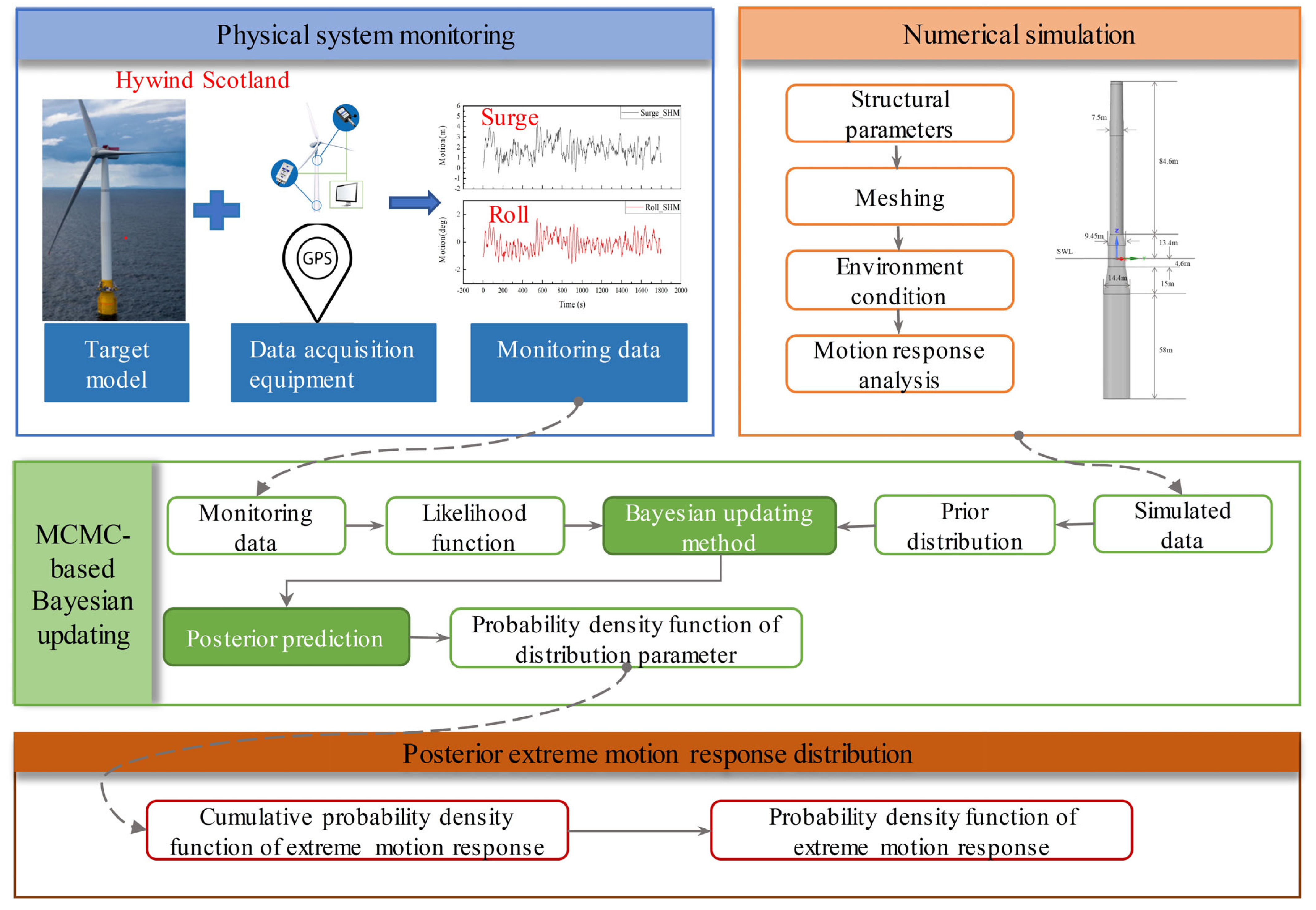

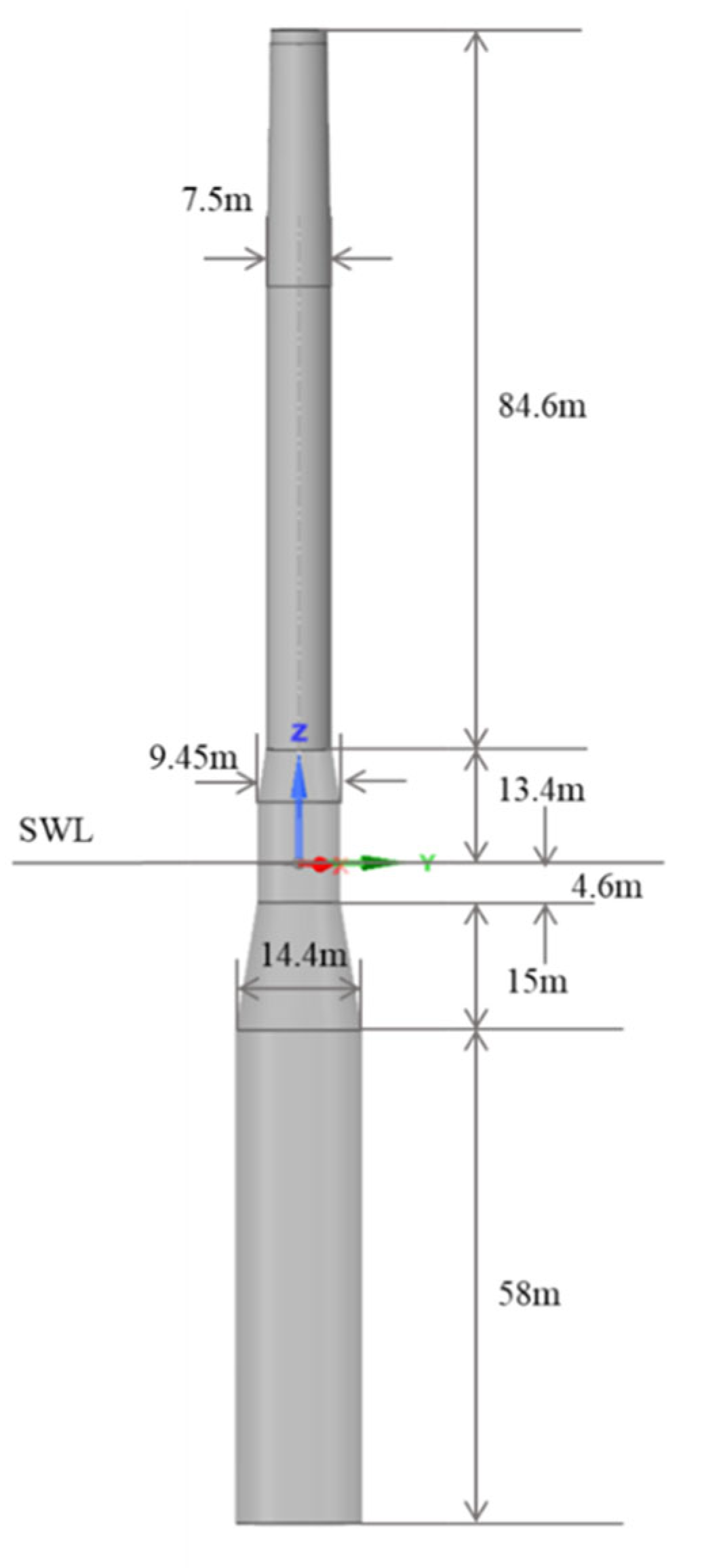

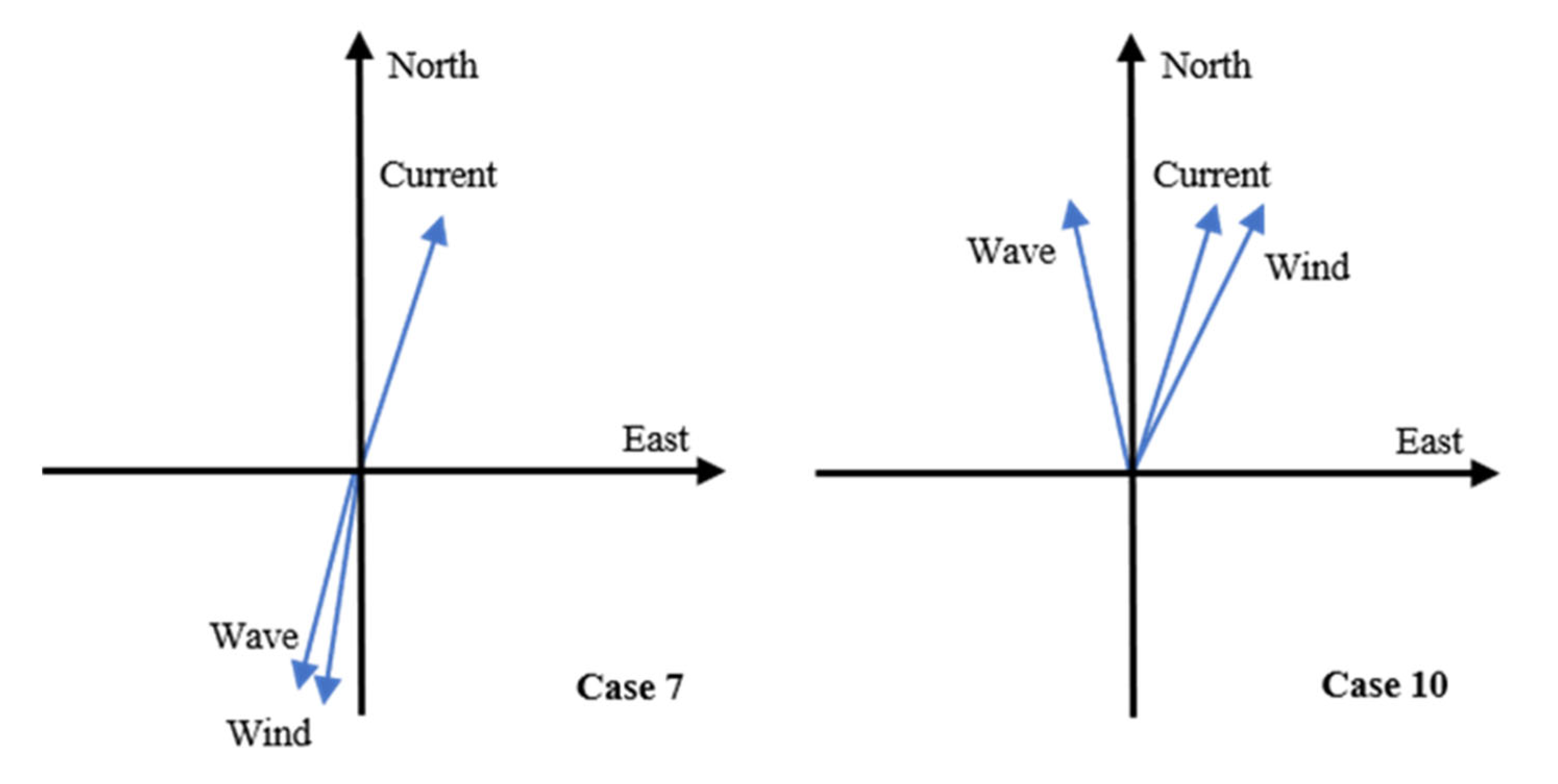
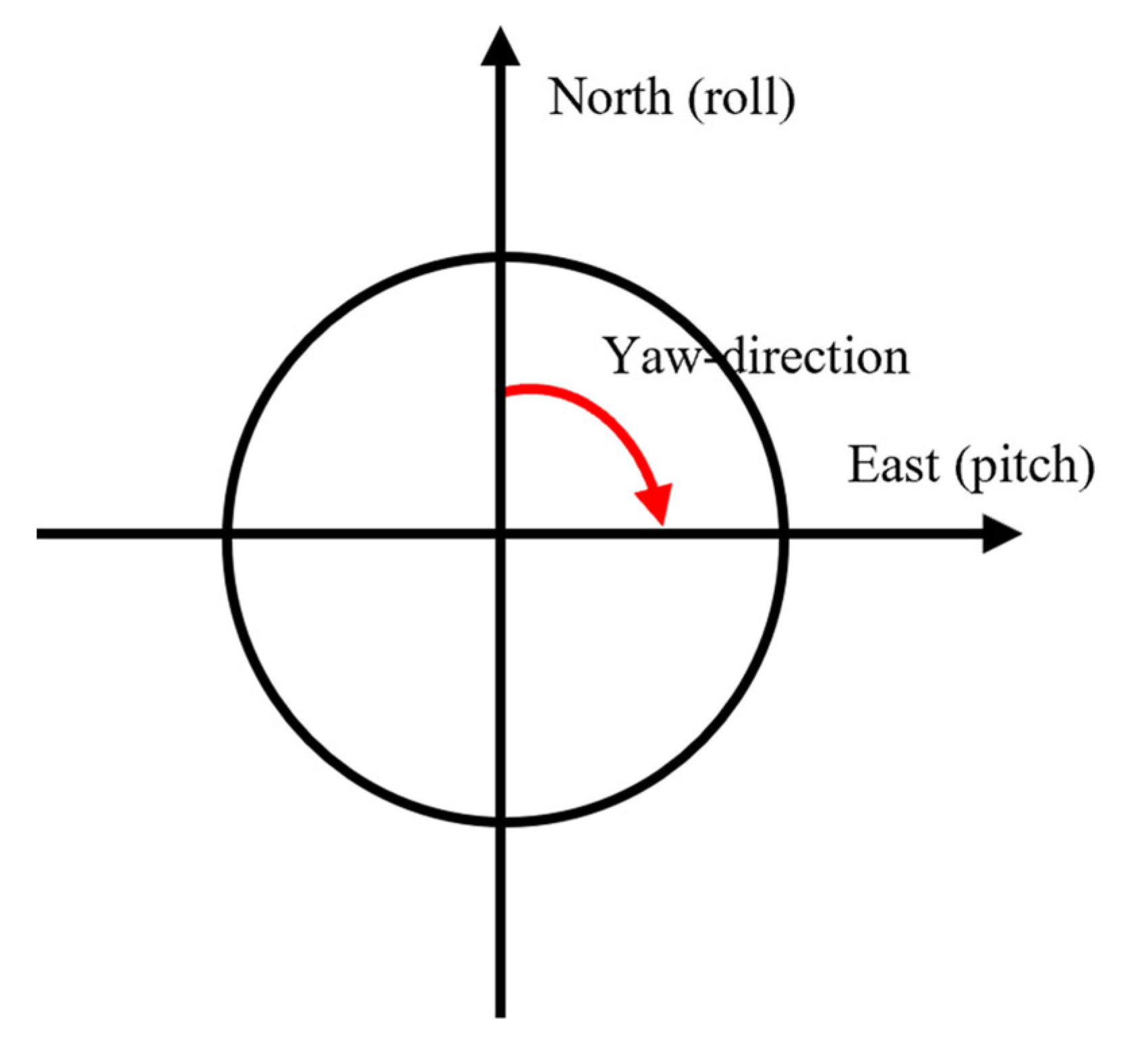
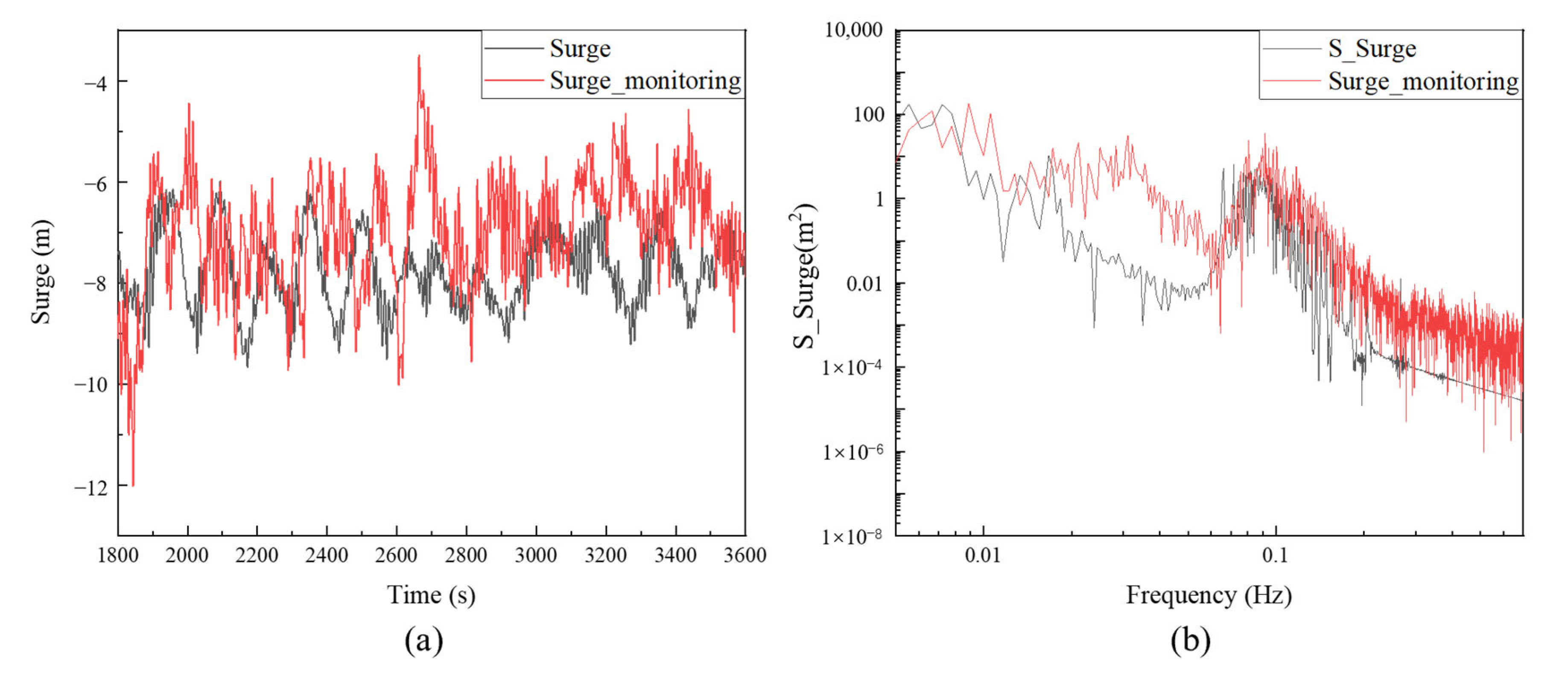


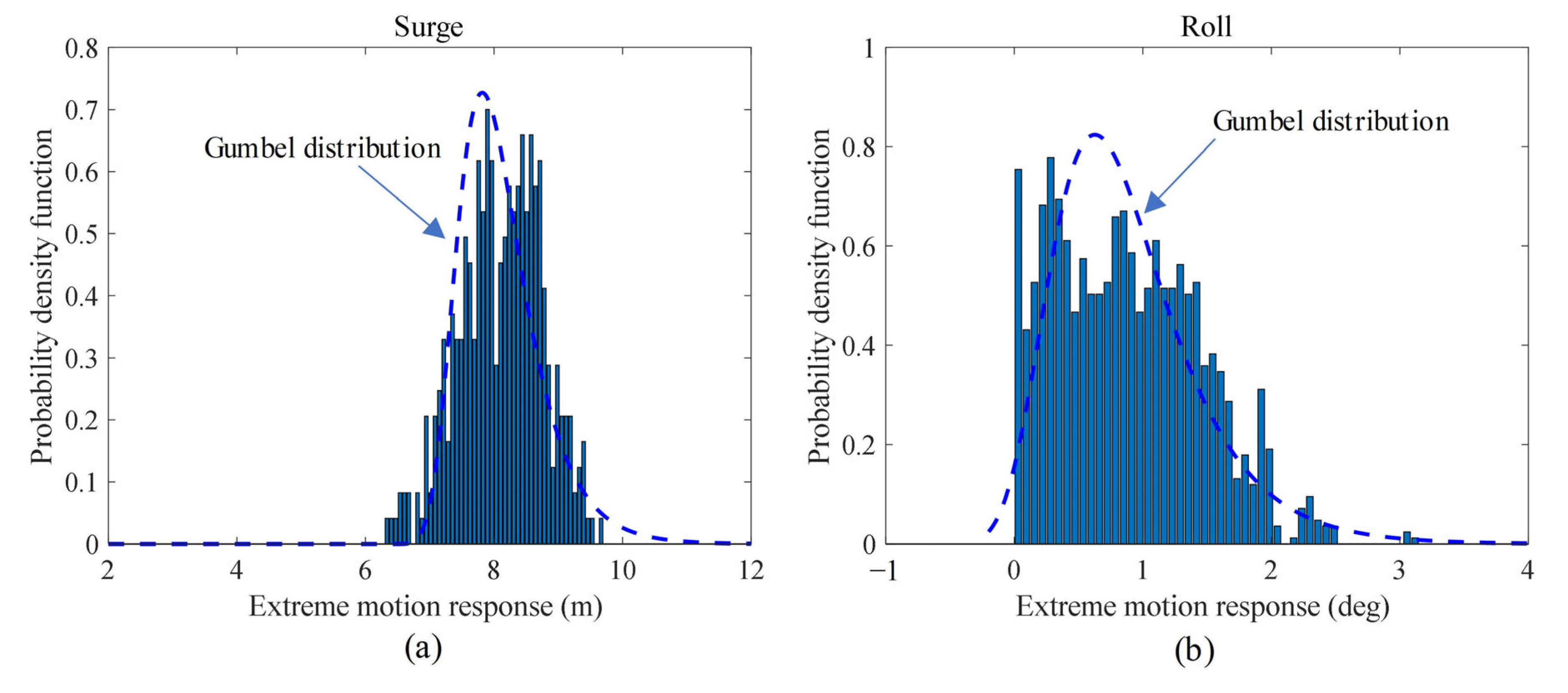
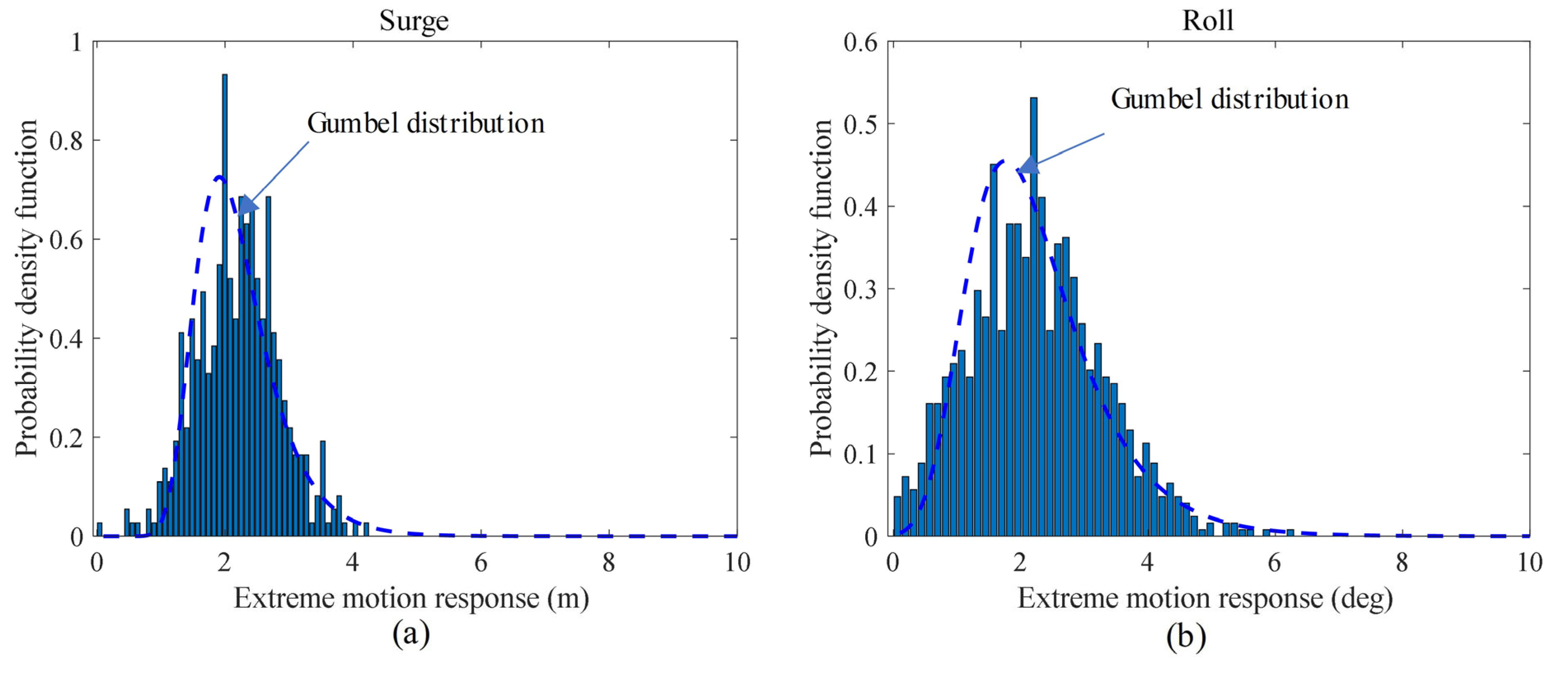

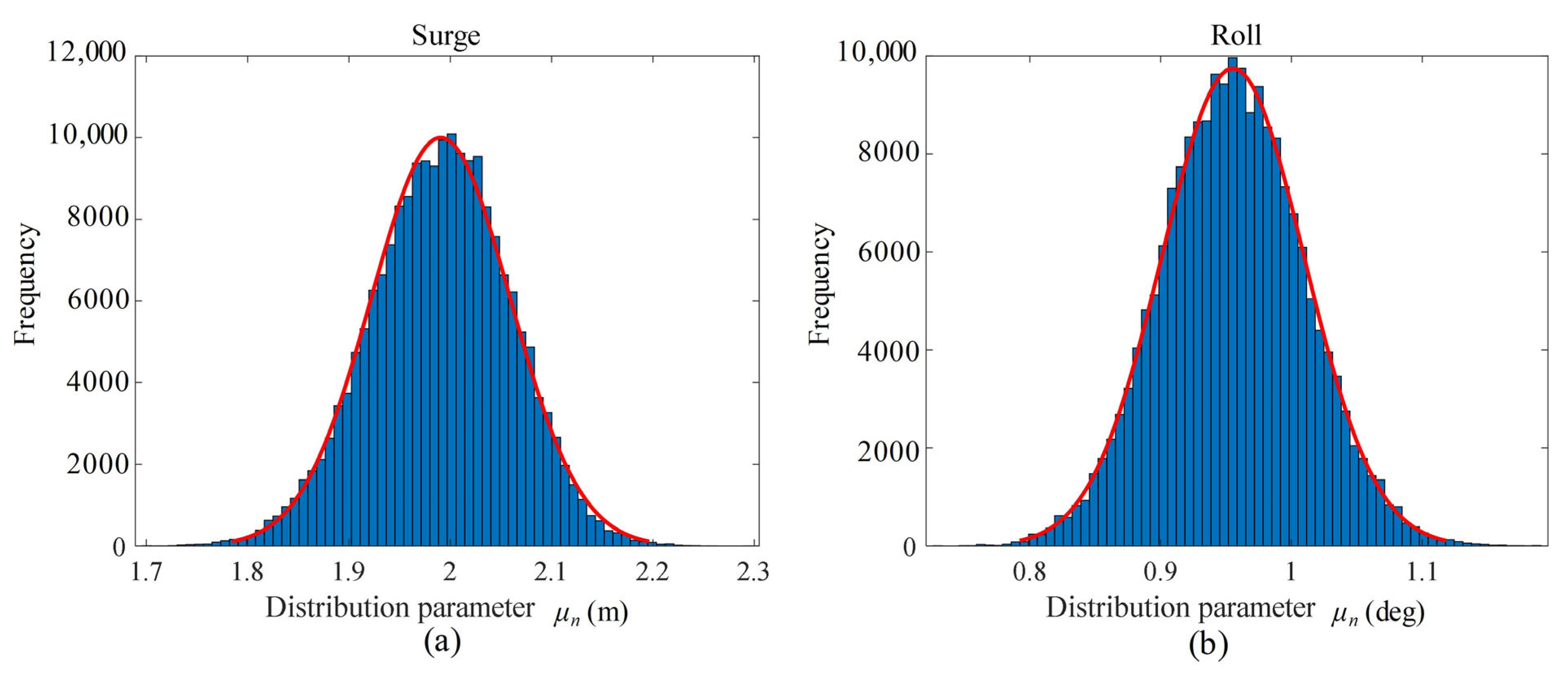
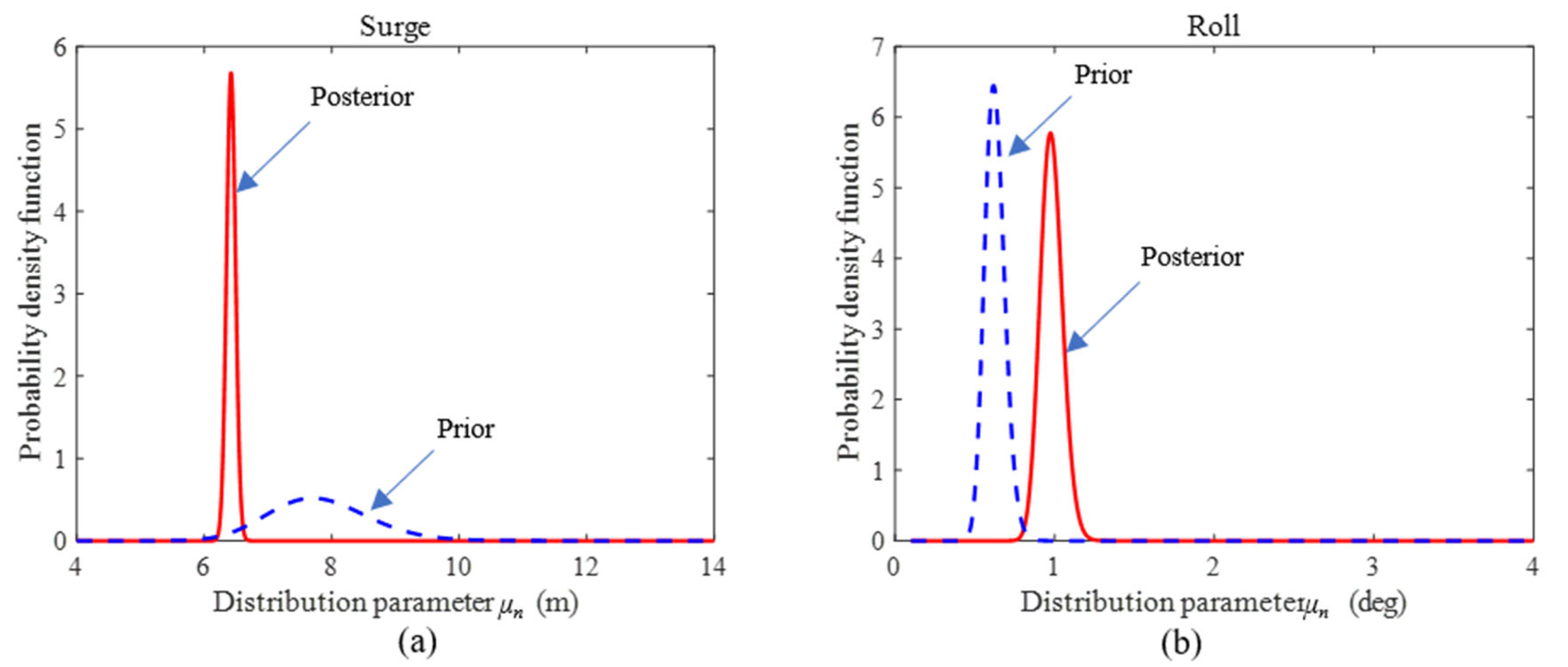



| Property | Unit | Value | |
|---|---|---|---|
| Water depth | m | 100 | |
| The radius of the anchors | m | 640 | |
| Draft of mooring points | m | 20.6 | |
| Number of lines | - | 3 | |
| Connection point outside wall | m | 0.8 | |
| Segment name (from top to bottom) | - | Bridle | Mainline |
| Segment length | m | 50 | 609.7 |
| Nominal diameter | mm | 132 | 147 |
| Young’s modulus | Mpa | 53,941 | 43,624 |
| Segment dry mass per meter | kg/m | 348.5 | 432.2 |
| Weight in water per meter | KN/m | 3.403 | 3.8707 |
| Property | Unit | Value | ||
|---|---|---|---|---|
| Draft | m | 77.6 | ||
| Displacement | tons | 11,754 | ||
| Dry mass | tons | 11,483 | ||
| Mooring tension | tons | 270.9 | ||
| X | Y | Z | ||
| Center of gravity | m | −0.14 | 0 | −50.03 |
| Center of buoyancy | m | 0 | 0 | −42.04 |
| Case No. | Wave Hight | Wave Period | Wave Direction | Wind Speed | Wind Direction | Current Speed | Current Direction |
|---|---|---|---|---|---|---|---|
| 7 | 4.4 m | 10.9 s | 17 deg | 13.7 m/s | 11 deg | 0.21 m/s | 19 deg |
| 10 | 3.9 m | 8.3 s | 174 deg | 30 m/s | 213 deg | 0.27 m/s | 27 deg |
| Simulated Data | Monitoring Data | |||
|---|---|---|---|---|
| Natural Period | Damping Ratio | Natural Period | Damping Ratio | |
| Surge | 91.63 | 0.0434 | 96 | 0.0445 |
| Sway | 91.6 | 0.0427 | 96 | 0.0441 |
| Heave | 26.28 | 0.0272 | 25.8 | 0.025 |
| Roll | 34.36 | 0.0245 | 33.7 | 0.0223 |
| Pitch | 34.59 | 0.0239 | 33.7 | 0.0233 |
| Yaw | 12.89 | 0.0414 | 13 | 0.0425 |
| Monitoring Data | Mean | Standard Deviation |
|---|---|---|
| Surge (Case 7) | 7.5799 | 1.1507 |
| Roll (Case 7) | 1.2324 | 0.3547 |
| Surge (Case 10) | 2.0699 | 0.8446 |
| Roll (Case 10) | −0.3601 | 0.5436 |
| Simulated Data | Mean | Standard Deviation |
| Surge (Case 7) | 8.1088 | 0.6490 |
| Roll (Case 7) | 0.8840 | 0.5725 |
| Surge (Case 10) | 2.2042 | 0.6504 |
| Roll (Case 10) | −2.2183 | 1.0627 |
| Likelihood Function | Distribution Type | ||
|---|---|---|---|
| Surge (Case 7) | 1.9763 | Gumbel | |
| Roll (Case 7) | 2.2402 | Gumbel | |
| Surge (Case 10) | 1.9719 | Gumbel | |
| Roll (Case 10) | 1.2374 | Gumbel | |
| Prior Function | Distribution Type | ||
| Surge (Case 7) | 0.0998 | 2.0513 | Lognormal |
| Roll (Case 7) | 0.0998 | −0.4728 | Lognormal |
| Surge (Case 10) | 0.0998 | 0.6429 | Lognormal |
| Roll (Case 10) | 0.0998 | 0.5628 | Lognormal |
| Case No. | Wave Hight | Motion | Prior Mean | Prior Standard Deviation | Posterior Mean | Posterior Standard Deviation | Reduction in Standard Deviation |
|---|---|---|---|---|---|---|---|
| 7 | Surge | 7.821 | 0.781 | 6.420 | 0.070 | 91.04% | |
| Roll | 0.626 | 0.062 | 0.981 | 0.070 | −12.9% | ||
| Extreme motion X | Surge | 8.109 | 0.649 | 6.712 | 0.640 | 1.39% | |
| Roll | 0.884 | 0.573 | 1.240 | 0.570 | 0.52% | ||
| 10 | Surge | 1.991 | 0.191 | 1.990 | 0.069 | 63.87% | |
| Roll | 1.764 | 0.184 | 0.955 | 0.055 | 70.11% | ||
| Extreme motion X | Surge | 2.204 | 0.650 | 2.283 | 0.650 | 0 | |
| Roll | −2.218 | 1.063 | −1.426 | 1.034 | 2.73% |
Disclaimer/Publisher’s Note: The statements, opinions and data contained in all publications are solely those of the individual author(s) and contributor(s) and not of MDPI and/or the editor(s). MDPI and/or the editor(s) disclaim responsibility for any injury to people or property resulting from any ideas, methods, instructions or products referred to in the content. |
© 2024 by the authors. Licensee MDPI, Basel, Switzerland. This article is an open access article distributed under the terms and conditions of the Creative Commons Attribution (CC BY) license (https://creativecommons.org/licenses/by/4.0/).
Share and Cite
Li, N.; Zou, G.; Feng, Y.; Ali, L. Probabilistic Prediction of Floating Offshore Wind Turbine Platform Motions via Uncertainty Quantification and Information Integration. J. Mar. Sci. Eng. 2024, 12, 886. https://doi.org/10.3390/jmse12060886
Li N, Zou G, Feng Y, Ali L. Probabilistic Prediction of Floating Offshore Wind Turbine Platform Motions via Uncertainty Quantification and Information Integration. Journal of Marine Science and Engineering. 2024; 12(6):886. https://doi.org/10.3390/jmse12060886
Chicago/Turabian StyleLi, Na, Guang Zou, Yu Feng, and Liaqat Ali. 2024. "Probabilistic Prediction of Floating Offshore Wind Turbine Platform Motions via Uncertainty Quantification and Information Integration" Journal of Marine Science and Engineering 12, no. 6: 886. https://doi.org/10.3390/jmse12060886
APA StyleLi, N., Zou, G., Feng, Y., & Ali, L. (2024). Probabilistic Prediction of Floating Offshore Wind Turbine Platform Motions via Uncertainty Quantification and Information Integration. Journal of Marine Science and Engineering, 12(6), 886. https://doi.org/10.3390/jmse12060886








